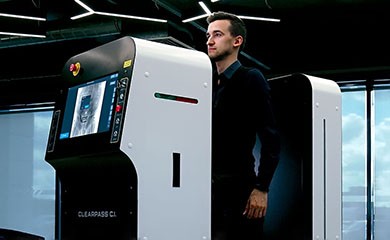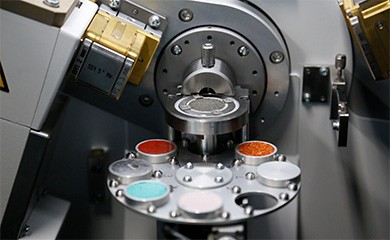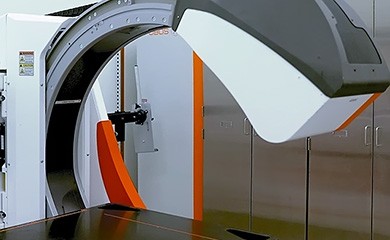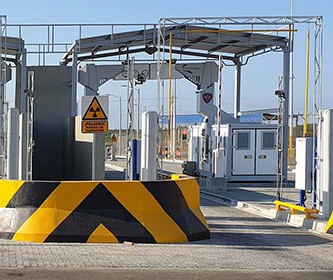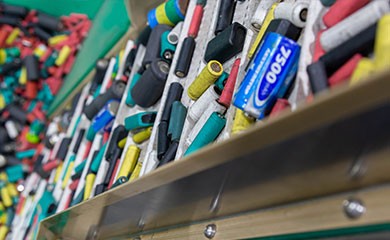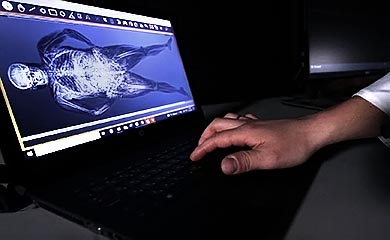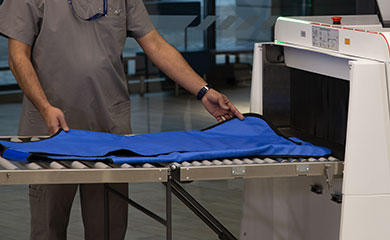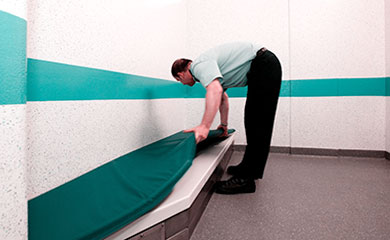X-ray powder diffraction (XRPD) is a fast and non-destructive technique of investigation of polycrystalline materials. The main task of the XRPD is a determination of the crystalline structure of a sample under investigation by measuring a reflected X-ray emission as a function of deflection angle. Further, this information can be used to identify the substances present in the sample and even determine their relative mass fractions. Most often, the polycrystalline samples are powder-like which gave the method its name.
How does X-ray powder diffraction (XRPD) work?
The phenomenon of X-ray diffraction is based on the interference of X-ray radiation reflected from various atomic planes within a crystalline lattice of a sample under investigation. The interference results in the appearance of distinct directions in space corresponding to the X-ray intensity maxima which can be measured using an X-ray diffractometer equipped with an X-ray source, detector and high-precision positioning system (goniometer).
The information is used to calculate the crystal lattice parameters and, therefore, identify the substances using validated crystallographic databases (COD, PDF, ICSD, etc.).
Strictly speaking, XRD can only be applied to direct investigation of crystalline substances in which atoms are arranged in a periodically repeating structure. On the other hand, most of the solid substances in the world are crystalline (metals, rocks, building materials, medicine and many others) which ensures extremely high applicability of XRD in many fields of industry and science.
Where is the X-ray powder diffractometer used?
X-ray diffraction is a versatile method of investigation which is widely used in various fields of science and industry, including:
- Cement production;
- Mining industry (mineral composition);
- Pharmaceutical production;
- Metallurgy;
- Chemical production and petrochemistry;
- Paint and protective coating production;
- Food and cosmetics production;
- Scientific research;
- Forensic analysis.
What are the advantages and limitations of X-ray powder diffraction (XRPD)?
Advantages of powder XRD:
- It is practically the only method for investigating the crystalline structure of substances. While there are other methods that allow direct observation of the crystalline structure of substances (scanning and transmission electron microscopy), they do not provide the required accuracy in determining interatomic distances and are not practically used for these purposes.
- Does not require time- and labor-intensive sample preparation.
- Non-destructive.
- Fast (typical measurement times take only a few minutes).
- Does not require special measurement conditions (vacuum, temperature), although such conditions can be created, if necessary, for investigating specific types of samples.
- Allows for relatively quick qualitative and quantitative analysis of multicomponent mixtures of unknown composition. With a well-established methodology for a specific type of sample, the analysis time does not exceed a few minutes.
Limitations of powder XRD:
- Since the method is based on the phenomenon of interference of X-rays reflected from periodically arranged atomic planes, its inherent limitation is the ability to investigate only substances with a crystalline structure. However, it is worth noting that there are several techniques that allow for the relatively accurate determination of the proportion of amorphous phase in a mixture with crystalline substances using X-ray diffraction (e.g., internal or external standard method, Rietveld method, etc.).
- Because X-ray radiation is difficult to focus, the minimum size of the sample under investigation is limited and practically cannot be smaller than several tens of micrometers.
- When investigating powdered materials, insufficient sample homogeneity in both phase and crystallite orientations can lead to significant errors in quantitative analysis results. To mitigate the influence of this factor, specialized sample stages with rotation capabilities are employed.
Despite its limitations, X-ray powder diffraction is a valuable method for characterizing crystalline materials and is widely used in research, industry, and academia.
Multi-function powder X-ray diffractometer from LINEV System
TELLUS is a desktop powder diffractometer that meets the highest requirements for this class of instruments and even exceeds expectations in some ways.
Experience rapid measurements with TELLUS, featuring the most advanced DECTRIS* MYTHEN2 R 1D detector. Conduct express analyses within minutes without compromising data quality.
The detector’s 100% quantum efficiency and its ability to accumulate the signal while keeping a low noise level make it possible to collect the highest-quality data. This powder diffractometer can analyze even tiny amounts of samples.
The high resolution of the detector and the precise positioning of the goniometer achieve accuracy better than +/-0.02° (2Ө) over the full angular range.
The software interface with predefined experimental scenarios makes the measurement process clear even for new users, though XRD experts can create their own protocol. The analysis software is based on advanced analytical methods to make the quantitative and qualitative analysis of samples more precise.
TELLUS is equipped with a detector and X-ray source with an extended lifetime, significantly reducing maintenance costs and saving money in the long run.
Advantages ALMAZ and TELLUSCon — specialized software powder XRD
- The software has access to COD (open access collection) and PDF-2 databases (optional).
- Interface optimized for advanced and non-experienced users.
- Measurement by steps or continuous scan.
- Predefined measurement scenarios.
- Data preprocessing (virtual monochromator, Lorentz-polarization factor correction, absorption correction, smoothing, background line definition).
- Peaks search.
- Qualitative phase analysis.
- Quantitative analysis with RIR and internal standard calibration methods.
- Refine lattice parameters using the pattern-fitting method (Rietveld, Pawley, Le Bail).
- Measurement and analysis reports.
